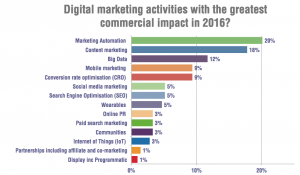Marketing Automation by Andrea Michelotti
The 2016 has just started, but what are your plans for this year? Many businesses are still working on building (or implementing) their online marketing strategy, and the trend for this year, is to automate marketing processes.
I was reading this article found on smartinsights.com that talks about the trends for the next 12 months and I guess that it’s not only a coincidence that marketing automation, has been voted by users as the most important thing to work on.
In the past years, businesses spent the majority of the time in content creation, branding and general optimization to be found on the internet.
The results of previous campaigns can be also seen as an increase of leads, orders or enquiries. Every balanced marketing strategy should cover, not only the capability of attracting new customers, but also an effective way to manage an eventual increase of leads.
This is what has been outlined to be the trend for the 2016, and it’s not surprising…
I think that many businesses are facing the problem on how to effectively manage the increase of leads generated. A good user management, is also meaningful in terms of customer care, and of an effective time management for employees.
Exactly, how can a business implement a marketing automation strategy?
At Ants Marching we love working with processes and numbers, and there is not a single answer to this question. Every business is different, and the only way to determine the best solution is to analyze how the business works, and what are the improvement areas to increase customer satisfaction.
Out on the internet is full of software, crm, wordpress plugins that can help marketing managers, but most of the times, the crucial point is to identify which are the areas that needs improvement.
CREATE A PROJECT.
To actuate marketing automation, a business must have clear in mind which are the areas that requires attention when managing leads, customers or potentials. A process mapping is required at this stage to draw a detailed picture of the current state of the customer management process.
We use the tools of the 6Sigma process improvement to Define, Measure, Analyse, Improve and Control (DMAIC) the process performance, and to determine the action plan.
The deliverables of the action plan will then become the requirements of the Marketing Automation tool. This doesn’t need to be a complex software, it could be also an structured Excel file, containing the information needed.
MAKE A BUSINESS CASE.
The Business Case for the project is needed because we do not want to waste money into complex software applications that are difficult to use and to understand. The success of the business automation is to simplify the customer management, in a sustainable way. Reporting is crucial in order to have always available the information to handle the communications between the customer and the company.
IMPLEMENT THE SOLUTION
Once the technical solution has been identified, you are ready to implement the Marketing Automation Layer, that will consist of a single software capable to manage all the processes related to customer.
HOW TO CHOOSE.
Depending on the type of business, and the outcome of the process analysis, you can decide to manage centrally all the customer information into one software. From our experience, these are some modular CRM software that can add a significant value to your company when managing customers.
Here you can find a nice article from Business News Daily that highlights the differences between a couple of CRM applications available on the market:
Zoho: Zoho CRM is powerful CRM software that doesn’t compromise on capabilities just because you’re not paying for it. Unlike other free CRM, Zoho CRM offers all the core functionalities of CRM software and lets you onboard up to 10 users at no extra cost. You’ll also have access to your data anytime, anywhere using Zoho CRM’s mobile app, without having to purchase a plan.
Insightly: Insightly is a simple, but feature-rich CRM software fits the bill for microbusinesses. It has all the basic capabilities that really small businesses need in a CRM software, but is also highly scalable as your business grows. Additionally, Insightly is one of the most affordable CRM solutions available; there’s a free version to help you get started, and paid plans start at a fraction of the price of comparable CRM software.
Salesforce: This is an all-in-one, cloud-based solution that has everything you need in a CRM software. Although this software is typically associated with larger businesses and enterprises, Salesforce’s small business edition lets you take advantage of the product’s robust set of CRM tools and resources at an affordable, small-business-friendly price. Part of Salesforce Small Business Solutions, the platform is very easy to use and includes key features like lead generation, contact and opportunity management, sales forecasting, workflow automation, and much more.






